CP1404/CP5632 Assignment 2: Reading List 2.0
VerifiedAdded on 2019/09/16
|6
|2354
|494
Project
AI Summary
This document outlines the requirements for CP1404/CP5632 Assignment 2, which involves creating a Graphical User Interface (GUI) application using Python 3 and the Kivy toolkit. The project requires students to build upon their previous assignment by implementing a book reading list program with features such as adding books, marking them as completed, and displaying book details. The assignment emphasizes the use of classes, methods, and proper coding practices, including version control with Git/GitHub. Students are also required to write a project reflection and adhere to specific GUI and coding requirements. The document includes a detailed marking scheme and submission guidelines.
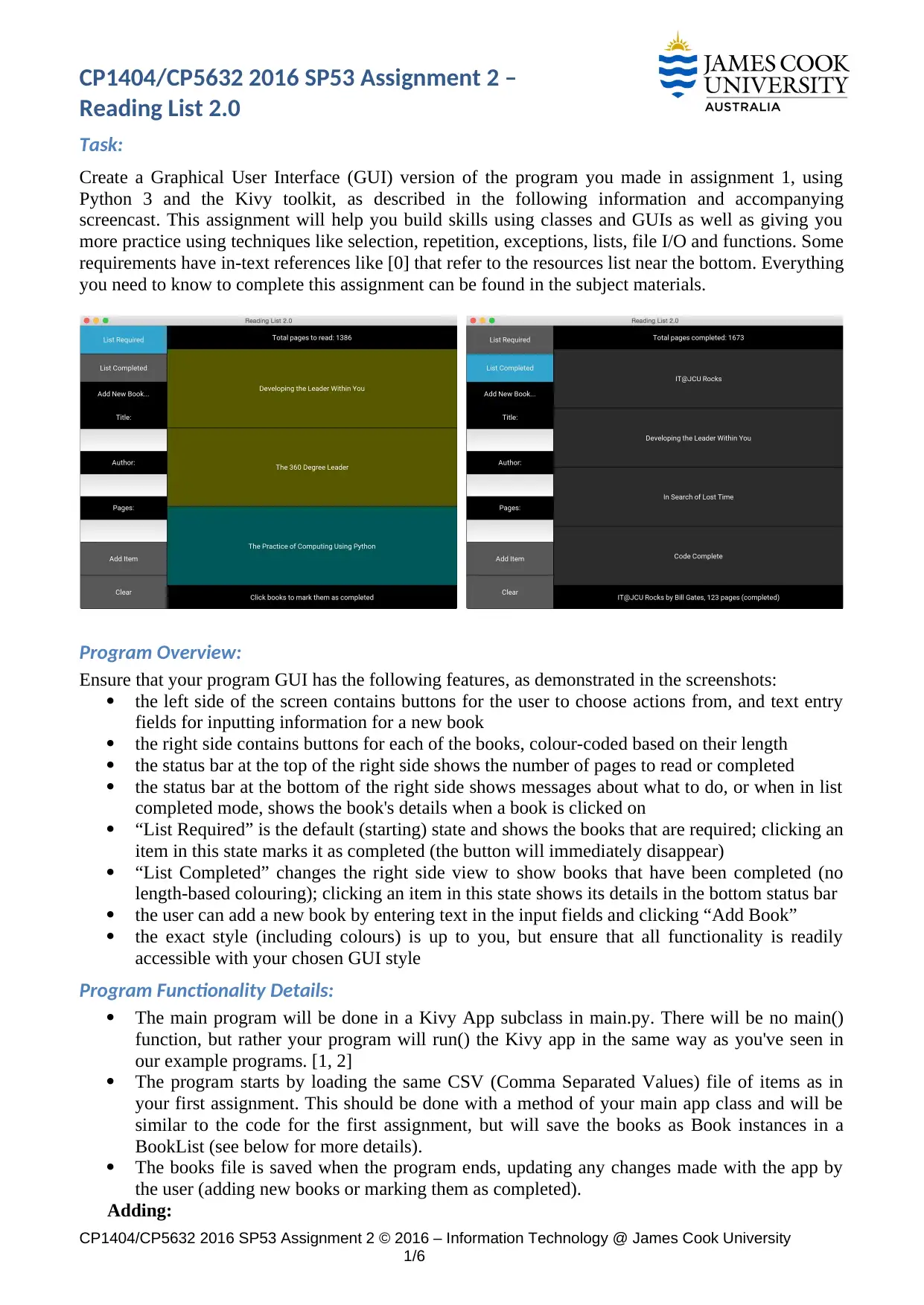
CP1404/CP5632 2016 SP53 Assignment 2 –
Reading List 2.0
Task:
Create a Graphical User Interface (GUI) version of the program you made in assignment 1, using
Python 3 and the Kivy toolkit, as described in the following information and accompanying
screencast. This assignment will help you build skills using classes and GUIs as well as giving you
more practice using techniques like selection, repetition, exceptions, lists, file I/O and functions. Some
requirements have in-text references like [0] that refer to the resources list near the bottom. Everything
you need to know to complete this assignment can be found in the subject materials.
Program Overview:
Ensure that your program GUI has the following features, as demonstrated in the screenshots:
the left side of the screen contains buttons for the user to choose actions from, and text entry
fields for inputting information for a new book
the right side contains buttons for each of the books, colour-coded based on their length
the status bar at the top of the right side shows the number of pages to read or completed
the status bar at the bottom of the right side shows messages about what to do, or when in list
completed mode, shows the book's details when a book is clicked on
“List Required” is the default (starting) state and shows the books that are required; clicking an
item in this state marks it as completed (the button will immediately disappear)
“List Completed” changes the right side view to show books that have been completed (no
length-based colouring); clicking an item in this state shows its details in the bottom status bar
the user can add a new book by entering text in the input fields and clicking “Add Book”
the exact style (including colours) is up to you, but ensure that all functionality is readily
accessible with your chosen GUI style
Program Functionality Details:
The main program will be done in a Kivy App subclass in main.py. There will be no main()
function, but rather your program will run() the Kivy app in the same way as you've seen in
our example programs. [1, 2]
The program starts by loading the same CSV (Comma Separated Values) file of items as in
your first assignment. This should be done with a method of your main app class and will be
similar to the code for the first assignment, but will save the books as Book instances in a
BookList (see below for more details).
The books file is saved when the program ends, updating any changes made with the app by
the user (adding new books or marking them as completed).
Adding:
CP1404/CP5632 2016 SP53 Assignment 2 © 2016 – Information Technology @ James Cook University
1/6
Reading List 2.0
Task:
Create a Graphical User Interface (GUI) version of the program you made in assignment 1, using
Python 3 and the Kivy toolkit, as described in the following information and accompanying
screencast. This assignment will help you build skills using classes and GUIs as well as giving you
more practice using techniques like selection, repetition, exceptions, lists, file I/O and functions. Some
requirements have in-text references like [0] that refer to the resources list near the bottom. Everything
you need to know to complete this assignment can be found in the subject materials.
Program Overview:
Ensure that your program GUI has the following features, as demonstrated in the screenshots:
the left side of the screen contains buttons for the user to choose actions from, and text entry
fields for inputting information for a new book
the right side contains buttons for each of the books, colour-coded based on their length
the status bar at the top of the right side shows the number of pages to read or completed
the status bar at the bottom of the right side shows messages about what to do, or when in list
completed mode, shows the book's details when a book is clicked on
“List Required” is the default (starting) state and shows the books that are required; clicking an
item in this state marks it as completed (the button will immediately disappear)
“List Completed” changes the right side view to show books that have been completed (no
length-based colouring); clicking an item in this state shows its details in the bottom status bar
the user can add a new book by entering text in the input fields and clicking “Add Book”
the exact style (including colours) is up to you, but ensure that all functionality is readily
accessible with your chosen GUI style
Program Functionality Details:
The main program will be done in a Kivy App subclass in main.py. There will be no main()
function, but rather your program will run() the Kivy app in the same way as you've seen in
our example programs. [1, 2]
The program starts by loading the same CSV (Comma Separated Values) file of items as in
your first assignment. This should be done with a method of your main app class and will be
similar to the code for the first assignment, but will save the books as Book instances in a
BookList (see below for more details).
The books file is saved when the program ends, updating any changes made with the app by
the user (adding new books or marking them as completed).
Adding:
CP1404/CP5632 2016 SP53 Assignment 2 © 2016 – Information Technology @ James Cook University
1/6
Paraphrase This Document
Need a fresh take? Get an instant paraphrase of this document with our AI Paraphraser
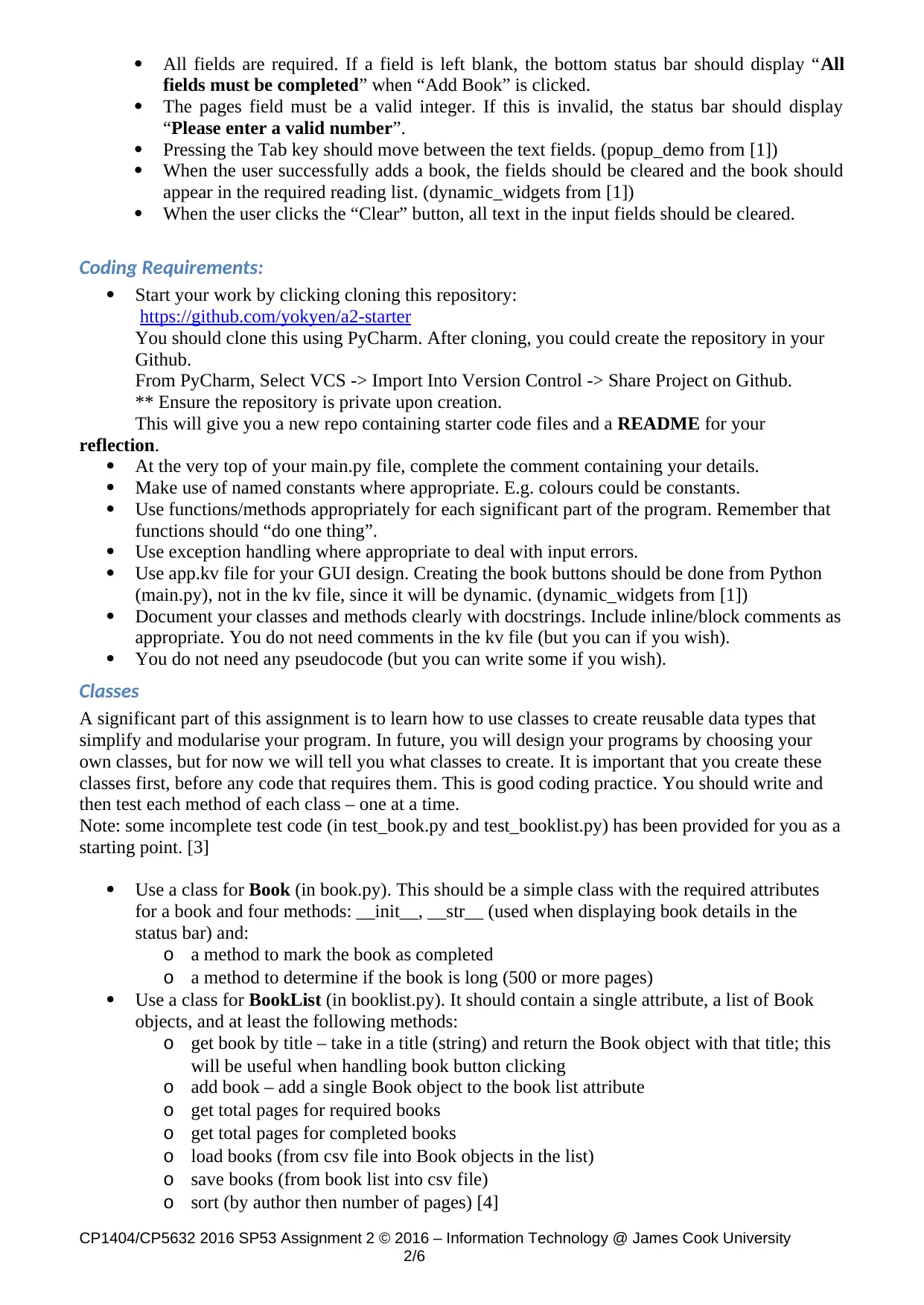
All fields are required. If a field is left blank, the bottom status bar should display “All
fields must be completed” when “Add Book” is clicked.
The pages field must be a valid integer. If this is invalid, the status bar should display
“Please enter a valid number”.
Pressing the Tab key should move between the text fields. (popup_demo from [1])
When the user successfully adds a book, the fields should be cleared and the book should
appear in the required reading list. (dynamic_widgets from [1])
When the user clicks the “Clear” button, all text in the input fields should be cleared.
Coding Requirements:
Start your work by clicking cloning this repository:
https://github.com/yokyen/a2-starter
You should clone this using PyCharm. After cloning, you could create the repository in your
Github.
From PyCharm, Select VCS -> Import Into Version Control -> Share Project on Github.
** Ensure the repository is private upon creation.
This will give you a new repo containing starter code files and a README for your
reflection.
At the very top of your main.py file, complete the comment containing your details.
Make use of named constants where appropriate. E.g. colours could be constants.
Use functions/methods appropriately for each significant part of the program. Remember that
functions should “do one thing”.
Use exception handling where appropriate to deal with input errors.
Use app.kv file for your GUI design. Creating the book buttons should be done from Python
(main.py), not in the kv file, since it will be dynamic. (dynamic_widgets from [1])
Document your classes and methods clearly with docstrings. Include inline/block comments as
appropriate. You do not need comments in the kv file (but you can if you wish).
You do not need any pseudocode (but you can write some if you wish).
Classes
A significant part of this assignment is to learn how to use classes to create reusable data types that
simplify and modularise your program. In future, you will design your programs by choosing your
own classes, but for now we will tell you what classes to create. It is important that you create these
classes first, before any code that requires them. This is good coding practice. You should write and
then test each method of each class – one at a time.
Note: some incomplete test code (in test_book.py and test_booklist.py) has been provided for you as a
starting point. [3]
Use a class for Book (in book.py). This should be a simple class with the required attributes
for a book and four methods: __init__, __str__ (used when displaying book details in the
status bar) and:
o a method to mark the book as completed
o a method to determine if the book is long (500 or more pages)
Use a class for BookList (in booklist.py). It should contain a single attribute, a list of Book
objects, and at least the following methods:
o get book by title – take in a title (string) and return the Book object with that title; this
will be useful when handling book button clicking
o add book – add a single Book object to the book list attribute
o get total pages for required books
o get total pages for completed books
o load books (from csv file into Book objects in the list)
o save books (from book list into csv file)
o sort (by author then number of pages) [4]
CP1404/CP5632 2016 SP53 Assignment 2 © 2016 – Information Technology @ James Cook University
2/6
fields must be completed” when “Add Book” is clicked.
The pages field must be a valid integer. If this is invalid, the status bar should display
“Please enter a valid number”.
Pressing the Tab key should move between the text fields. (popup_demo from [1])
When the user successfully adds a book, the fields should be cleared and the book should
appear in the required reading list. (dynamic_widgets from [1])
When the user clicks the “Clear” button, all text in the input fields should be cleared.
Coding Requirements:
Start your work by clicking cloning this repository:
https://github.com/yokyen/a2-starter
You should clone this using PyCharm. After cloning, you could create the repository in your
Github.
From PyCharm, Select VCS -> Import Into Version Control -> Share Project on Github.
** Ensure the repository is private upon creation.
This will give you a new repo containing starter code files and a README for your
reflection.
At the very top of your main.py file, complete the comment containing your details.
Make use of named constants where appropriate. E.g. colours could be constants.
Use functions/methods appropriately for each significant part of the program. Remember that
functions should “do one thing”.
Use exception handling where appropriate to deal with input errors.
Use app.kv file for your GUI design. Creating the book buttons should be done from Python
(main.py), not in the kv file, since it will be dynamic. (dynamic_widgets from [1])
Document your classes and methods clearly with docstrings. Include inline/block comments as
appropriate. You do not need comments in the kv file (but you can if you wish).
You do not need any pseudocode (but you can write some if you wish).
Classes
A significant part of this assignment is to learn how to use classes to create reusable data types that
simplify and modularise your program. In future, you will design your programs by choosing your
own classes, but for now we will tell you what classes to create. It is important that you create these
classes first, before any code that requires them. This is good coding practice. You should write and
then test each method of each class – one at a time.
Note: some incomplete test code (in test_book.py and test_booklist.py) has been provided for you as a
starting point. [3]
Use a class for Book (in book.py). This should be a simple class with the required attributes
for a book and four methods: __init__, __str__ (used when displaying book details in the
status bar) and:
o a method to mark the book as completed
o a method to determine if the book is long (500 or more pages)
Use a class for BookList (in booklist.py). It should contain a single attribute, a list of Book
objects, and at least the following methods:
o get book by title – take in a title (string) and return the Book object with that title; this
will be useful when handling book button clicking
o add book – add a single Book object to the book list attribute
o get total pages for required books
o get total pages for completed books
o load books (from csv file into Book objects in the list)
o save books (from book list into csv file)
o sort (by author then number of pages) [4]
CP1404/CP5632 2016 SP53 Assignment 2 © 2016 – Information Technology @ James Cook University
2/6
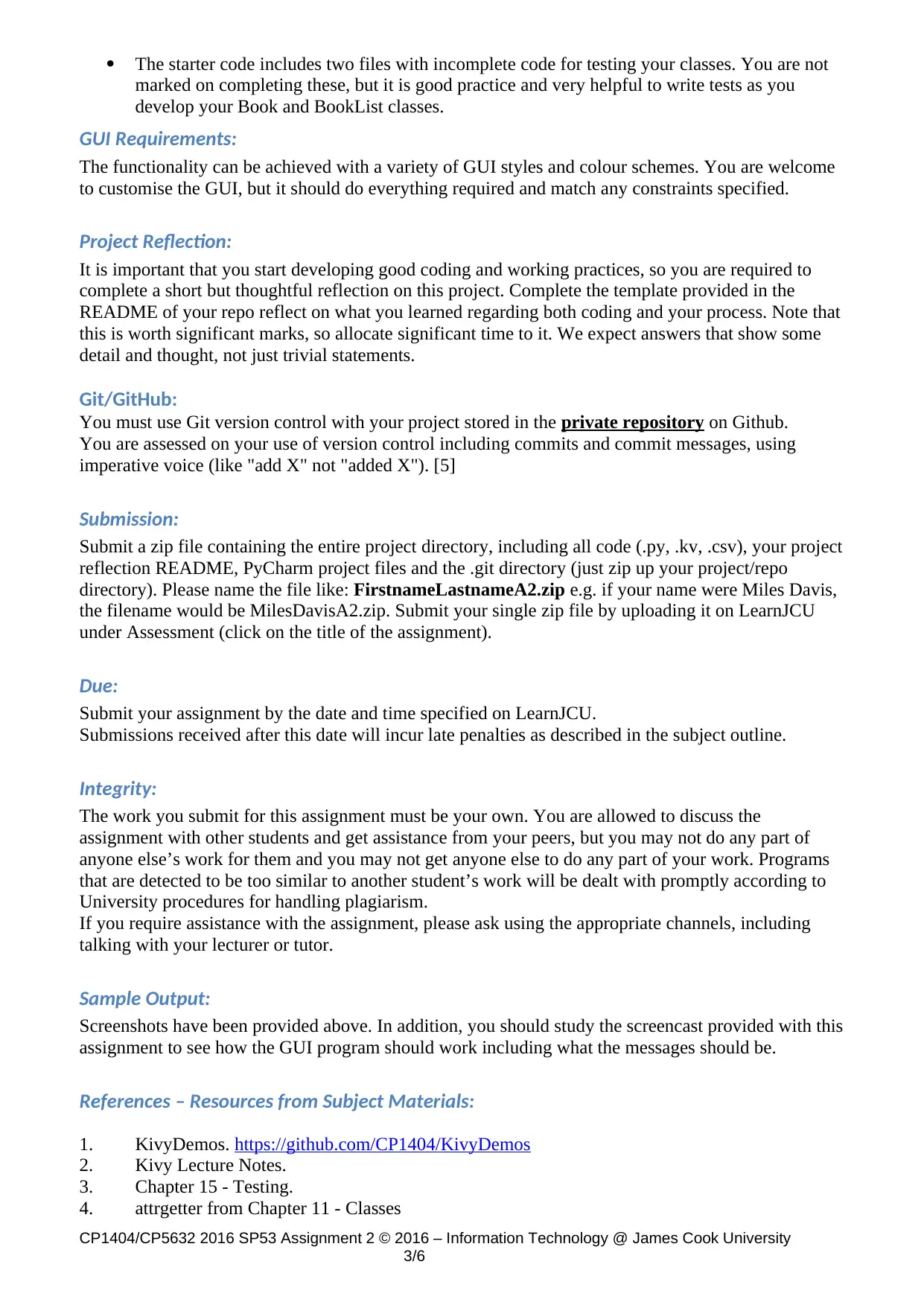
The starter code includes two files with incomplete code for testing your classes. You are not
marked on completing these, but it is good practice and very helpful to write tests as you
develop your Book and BookList classes.
GUI Requirements:
The functionality can be achieved with a variety of GUI styles and colour schemes. You are welcome
to customise the GUI, but it should do everything required and match any constraints specified.
Project Reflection:
It is important that you start developing good coding and working practices, so you are required to
complete a short but thoughtful reflection on this project. Complete the template provided in the
README of your repo reflect on what you learned regarding both coding and your process. Note that
this is worth significant marks, so allocate significant time to it. We expect answers that show some
detail and thought, not just trivial statements.
Git/GitHub:
You must use Git version control with your project stored in the private repository on Github.
You are assessed on your use of version control including commits and commit messages, using
imperative voice (like "add X" not "added X"). [5]
Submission:
Submit a zip file containing the entire project directory, including all code (.py, .kv, .csv), your project
reflection README, PyCharm project files and the .git directory (just zip up your project/repo
directory). Please name the file like: FirstnameLastnameA2.zip e.g. if your name were Miles Davis,
the filename would be MilesDavisA2.zip. Submit your single zip file by uploading it on LearnJCU
under Assessment (click on the title of the assignment).
Due:
Submit your assignment by the date and time specified on LearnJCU.
Submissions received after this date will incur late penalties as described in the subject outline.
Integrity:
The work you submit for this assignment must be your own. You are allowed to discuss the
assignment with other students and get assistance from your peers, but you may not do any part of
anyone else’s work for them and you may not get anyone else to do any part of your work. Programs
that are detected to be too similar to another student’s work will be dealt with promptly according to
University procedures for handling plagiarism.
If you require assistance with the assignment, please ask using the appropriate channels, including
talking with your lecturer or tutor.
Sample Output:
Screenshots have been provided above. In addition, you should study the screencast provided with this
assignment to see how the GUI program should work including what the messages should be.
References – Resources from Subject Materials:
1. KivyDemos. https://github.com/CP1404/KivyDemos
2. Kivy Lecture Notes.
3. Chapter 15 - Testing.
4. attrgetter from Chapter 11 - Classes
CP1404/CP5632 2016 SP53 Assignment 2 © 2016 – Information Technology @ James Cook University
3/6
marked on completing these, but it is good practice and very helpful to write tests as you
develop your Book and BookList classes.
GUI Requirements:
The functionality can be achieved with a variety of GUI styles and colour schemes. You are welcome
to customise the GUI, but it should do everything required and match any constraints specified.
Project Reflection:
It is important that you start developing good coding and working practices, so you are required to
complete a short but thoughtful reflection on this project. Complete the template provided in the
README of your repo reflect on what you learned regarding both coding and your process. Note that
this is worth significant marks, so allocate significant time to it. We expect answers that show some
detail and thought, not just trivial statements.
Git/GitHub:
You must use Git version control with your project stored in the private repository on Github.
You are assessed on your use of version control including commits and commit messages, using
imperative voice (like "add X" not "added X"). [5]
Submission:
Submit a zip file containing the entire project directory, including all code (.py, .kv, .csv), your project
reflection README, PyCharm project files and the .git directory (just zip up your project/repo
directory). Please name the file like: FirstnameLastnameA2.zip e.g. if your name were Miles Davis,
the filename would be MilesDavisA2.zip. Submit your single zip file by uploading it on LearnJCU
under Assessment (click on the title of the assignment).
Due:
Submit your assignment by the date and time specified on LearnJCU.
Submissions received after this date will incur late penalties as described in the subject outline.
Integrity:
The work you submit for this assignment must be your own. You are allowed to discuss the
assignment with other students and get assistance from your peers, but you may not do any part of
anyone else’s work for them and you may not get anyone else to do any part of your work. Programs
that are detected to be too similar to another student’s work will be dealt with promptly according to
University procedures for handling plagiarism.
If you require assistance with the assignment, please ask using the appropriate channels, including
talking with your lecturer or tutor.
Sample Output:
Screenshots have been provided above. In addition, you should study the screencast provided with this
assignment to see how the GUI program should work including what the messages should be.
References – Resources from Subject Materials:
1. KivyDemos. https://github.com/CP1404/KivyDemos
2. Kivy Lecture Notes.
3. Chapter 15 - Testing.
4. attrgetter from Chapter 11 - Classes
CP1404/CP5632 2016 SP53 Assignment 2 © 2016 – Information Technology @ James Cook University
3/6
⊘ This is a preview!⊘
Do you want full access?
Subscribe today to unlock all pages.

Trusted by 1+ million students worldwide
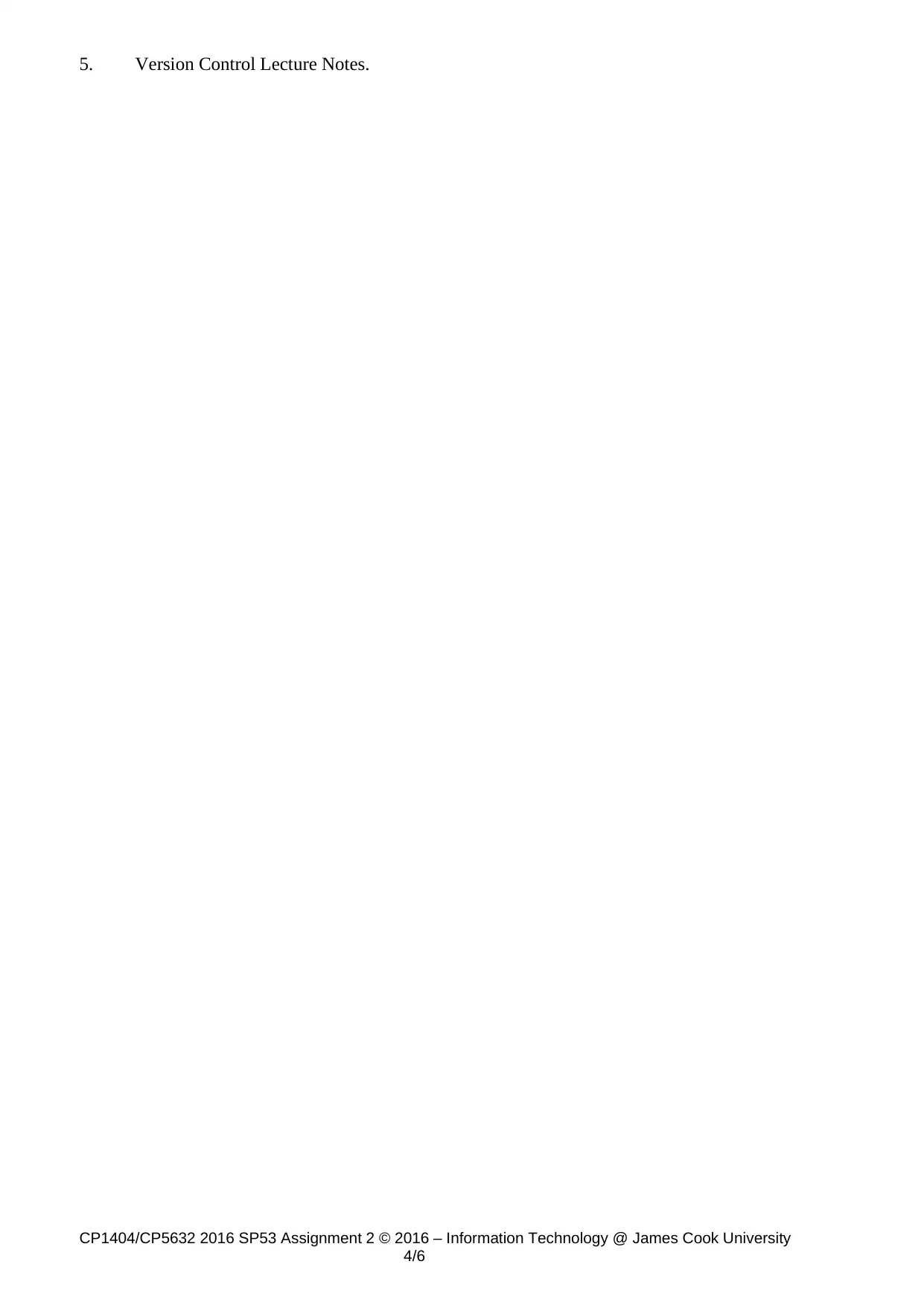
5. Version Control Lecture Notes.
CP1404/CP5632 2016 SP53 Assignment 2 © 2016 – Information Technology @ James Cook University
4/6
CP1404/CP5632 2016 SP53 Assignment 2 © 2016 – Information Technology @ James Cook University
4/6
Paraphrase This Document
Need a fresh take? Get an instant paraphrase of this document with our AI Paraphraser
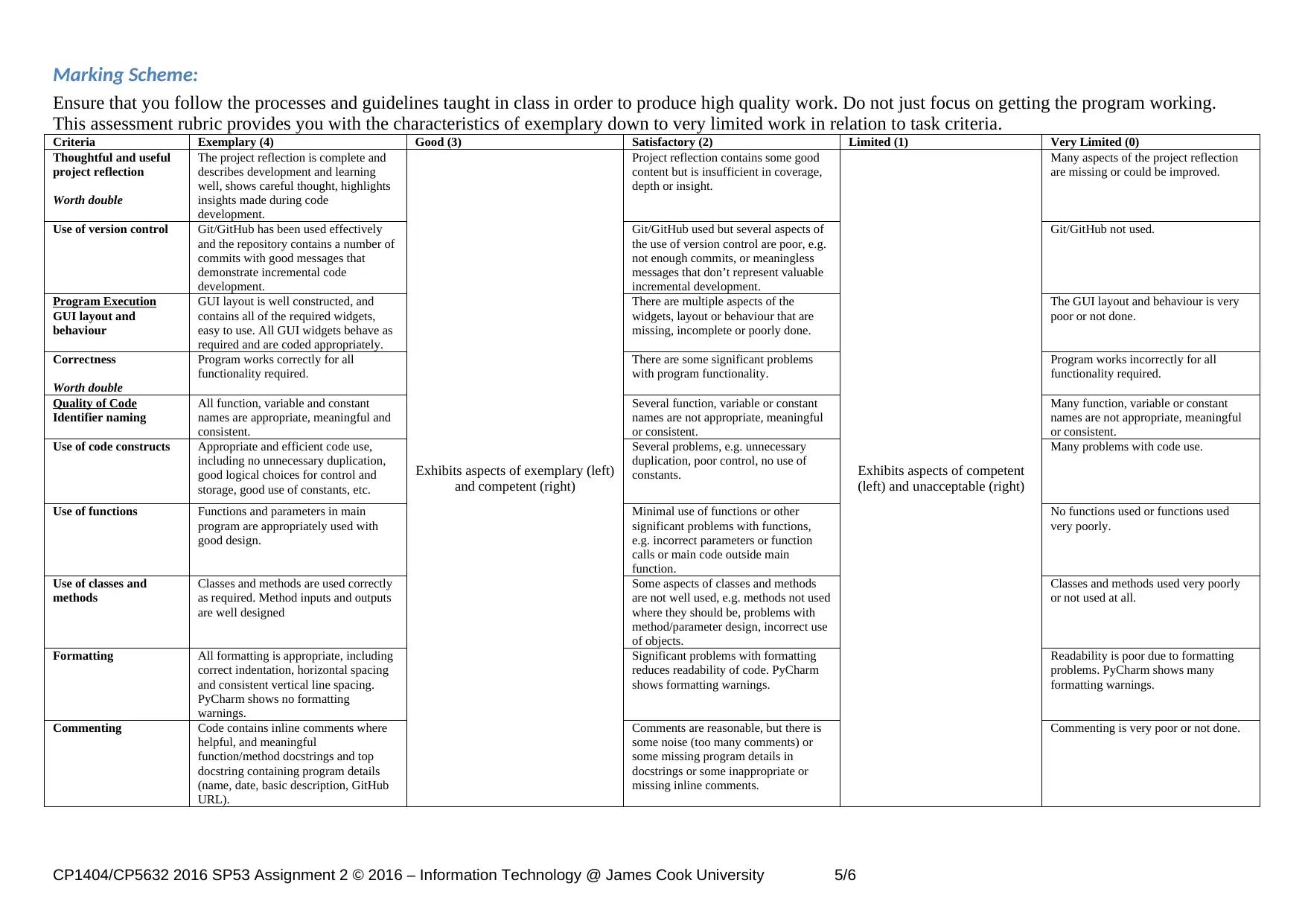
Marking Scheme:
Ensure that you follow the processes and guidelines taught in class in order to produce high quality work. Do not just focus on getting the program working.
This assessment rubric provides you with the characteristics of exemplary down to very limited work in relation to task criteria.
Criteria Exemplary (4) Good (3) Satisfactory (2) Limited (1) Very Limited (0)
Thoughtful and useful
project reflection
Worth double
The project reflection is complete and
describes development and learning
well, shows careful thought, highlights
insights made during code
development.
Exhibits aspects of exemplary (left)
and competent (right)
Project reflection contains some good
content but is insufficient in coverage,
depth or insight.
Exhibits aspects of competent
(left) and unacceptable (right)
Many aspects of the project reflection
are missing or could be improved.
Use of version control Git/GitHub has been used effectively
and the repository contains a number of
commits with good messages that
demonstrate incremental code
development.
Git/GitHub used but several aspects of
the use of version control are poor, e.g.
not enough commits, or meaningless
messages that don’t represent valuable
incremental development.
Git/GitHub not used.
Program Execution
GUI layout and
behaviour
GUI layout is well constructed, and
contains all of the required widgets,
easy to use. All GUI widgets behave as
required and are coded appropriately.
There are multiple aspects of the
widgets, layout or behaviour that are
missing, incomplete or poorly done.
The GUI layout and behaviour is very
poor or not done.
Correctness
Worth double
Program works correctly for all
functionality required.
There are some significant problems
with program functionality.
Program works incorrectly for all
functionality required.
Quality of Code
Identifier naming
All function, variable and constant
names are appropriate, meaningful and
consistent.
Several function, variable or constant
names are not appropriate, meaningful
or consistent.
Many function, variable or constant
names are not appropriate, meaningful
or consistent.
Use of code constructs Appropriate and efficient code use,
including no unnecessary duplication,
good logical choices for control and
storage, good use of constants, etc.
Several problems, e.g. unnecessary
duplication, poor control, no use of
constants.
Many problems with code use.
Use of functions Functions and parameters in main
program are appropriately used with
good design.
Minimal use of functions or other
significant problems with functions,
e.g. incorrect parameters or function
calls or main code outside main
function.
No functions used or functions used
very poorly.
Use of classes and
methods
Classes and methods are used correctly
as required. Method inputs and outputs
are well designed
Some aspects of classes and methods
are not well used, e.g. methods not used
where they should be, problems with
method/parameter design, incorrect use
of objects.
Classes and methods used very poorly
or not used at all.
Formatting All formatting is appropriate, including
correct indentation, horizontal spacing
and consistent vertical line spacing.
PyCharm shows no formatting
warnings.
Significant problems with formatting
reduces readability of code. PyCharm
shows formatting warnings.
Readability is poor due to formatting
problems. PyCharm shows many
formatting warnings.
Commenting Code contains inline comments where
helpful, and meaningful
function/method docstrings and top
docstring containing program details
(name, date, basic description, GitHub
URL).
Comments are reasonable, but there is
some noise (too many comments) or
some missing program details in
docstrings or some inappropriate or
missing inline comments.
Commenting is very poor or not done.
CP1404/CP5632 2016 SP53 Assignment 2 © 2016 – Information Technology @ James Cook University 5/6
Ensure that you follow the processes and guidelines taught in class in order to produce high quality work. Do not just focus on getting the program working.
This assessment rubric provides you with the characteristics of exemplary down to very limited work in relation to task criteria.
Criteria Exemplary (4) Good (3) Satisfactory (2) Limited (1) Very Limited (0)
Thoughtful and useful
project reflection
Worth double
The project reflection is complete and
describes development and learning
well, shows careful thought, highlights
insights made during code
development.
Exhibits aspects of exemplary (left)
and competent (right)
Project reflection contains some good
content but is insufficient in coverage,
depth or insight.
Exhibits aspects of competent
(left) and unacceptable (right)
Many aspects of the project reflection
are missing or could be improved.
Use of version control Git/GitHub has been used effectively
and the repository contains a number of
commits with good messages that
demonstrate incremental code
development.
Git/GitHub used but several aspects of
the use of version control are poor, e.g.
not enough commits, or meaningless
messages that don’t represent valuable
incremental development.
Git/GitHub not used.
Program Execution
GUI layout and
behaviour
GUI layout is well constructed, and
contains all of the required widgets,
easy to use. All GUI widgets behave as
required and are coded appropriately.
There are multiple aspects of the
widgets, layout or behaviour that are
missing, incomplete or poorly done.
The GUI layout and behaviour is very
poor or not done.
Correctness
Worth double
Program works correctly for all
functionality required.
There are some significant problems
with program functionality.
Program works incorrectly for all
functionality required.
Quality of Code
Identifier naming
All function, variable and constant
names are appropriate, meaningful and
consistent.
Several function, variable or constant
names are not appropriate, meaningful
or consistent.
Many function, variable or constant
names are not appropriate, meaningful
or consistent.
Use of code constructs Appropriate and efficient code use,
including no unnecessary duplication,
good logical choices for control and
storage, good use of constants, etc.
Several problems, e.g. unnecessary
duplication, poor control, no use of
constants.
Many problems with code use.
Use of functions Functions and parameters in main
program are appropriately used with
good design.
Minimal use of functions or other
significant problems with functions,
e.g. incorrect parameters or function
calls or main code outside main
function.
No functions used or functions used
very poorly.
Use of classes and
methods
Classes and methods are used correctly
as required. Method inputs and outputs
are well designed
Some aspects of classes and methods
are not well used, e.g. methods not used
where they should be, problems with
method/parameter design, incorrect use
of objects.
Classes and methods used very poorly
or not used at all.
Formatting All formatting is appropriate, including
correct indentation, horizontal spacing
and consistent vertical line spacing.
PyCharm shows no formatting
warnings.
Significant problems with formatting
reduces readability of code. PyCharm
shows formatting warnings.
Readability is poor due to formatting
problems. PyCharm shows many
formatting warnings.
Commenting Code contains inline comments where
helpful, and meaningful
function/method docstrings and top
docstring containing program details
(name, date, basic description, GitHub
URL).
Comments are reasonable, but there is
some noise (too many comments) or
some missing program details in
docstrings or some inappropriate or
missing inline comments.
Commenting is very poor or not done.
CP1404/CP5632 2016 SP53 Assignment 2 © 2016 – Information Technology @ James Cook University 5/6
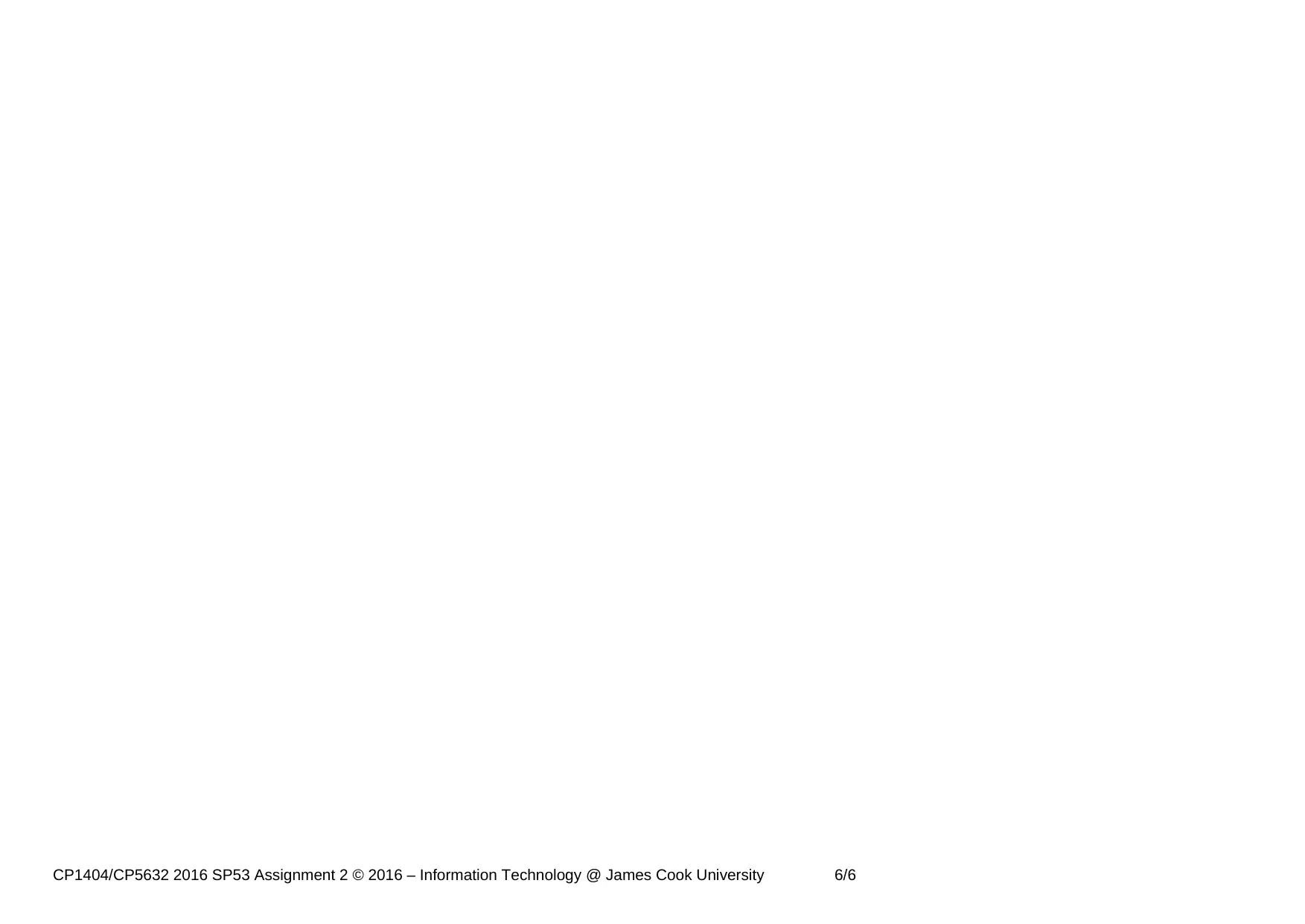
CP1404/CP5632 2016 SP53 Assignment 2 © 2016 – Information Technology @ James Cook University 6/6
⊘ This is a preview!⊘
Do you want full access?
Subscribe today to unlock all pages.

Trusted by 1+ million students worldwide
1 out of 6
Related Documents
Your All-in-One AI-Powered Toolkit for Academic Success.
+13062052269
info@desklib.com
Available 24*7 on WhatsApp / Email
![[object Object]](/_next/static/media/star-bottom.7253800d.svg)
Unlock your academic potential
Copyright © 2020–2025 A2Z Services. All Rights Reserved. Developed and managed by ZUCOL.




